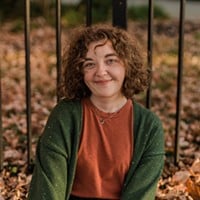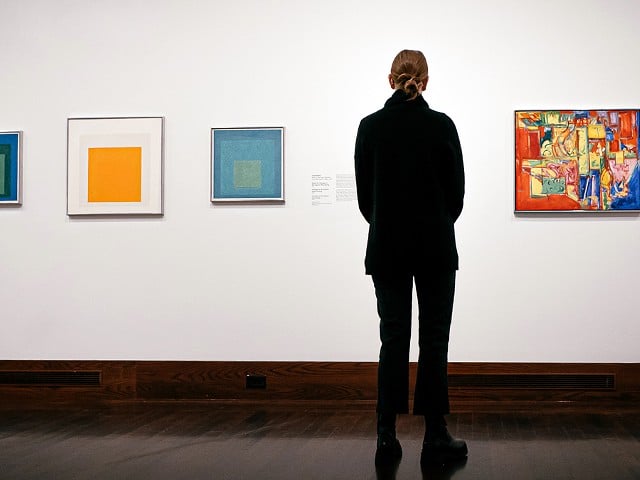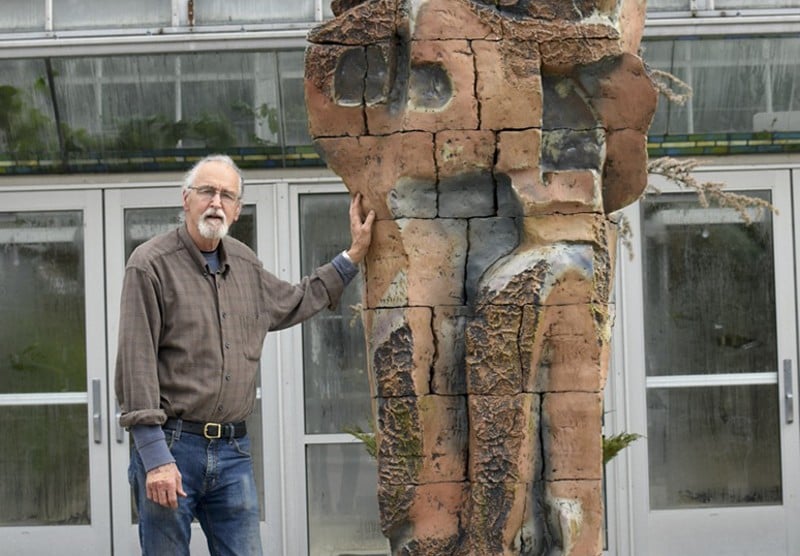
More than 70 ceramic sculptures are now nestled carefully throughout Krohn Conservatory’s lush plant houses.
Featuring the work of regional artists Roy Cartwright, Lisa Merida-Paytes and Robert Pulley, the Ceramics in a Garden exhibit aims to expand the public’s perception of outdoor ceramics and what they can add to garden spaces.
Walk into Krohn’s atrium and look up: leaf-like sculptures dangle from the ceiling and appear a shimmery reddish-brown hue when light filters into the space. Titled "Red Helix," the work by Merida-Paytes is made from steel, copper and paperclay.
Every piece for Ceramics in a Garden was designed and placed with a natural setting in mind, curators say.
“I really liked the notion that you go on a journey and you discover art. In doing that, you think about the plants,” says Mary Heider, an assistant dean emerita of the University of Cincinnati’s College of Medicine and curator for the exhibit. “You think about the shapes, the textures, the colors, and ‘Where does this art really look wonderful or accentuate some commonality with the plant material?’ That’s one of the things I’m trying to do in this exhibit at the Krohn.”
Strolling through the plant houses (palm, fern, bonsai, desert and orchid), one will find ceramic fish, basins, spirit markers, skeletal creatures and abstract forms that range from bulbous to geometric. The ceramics are placed with intention in and around Krohn’s plant beds. All work featured is available for purchase. QR codes that link to buying information are on each placard along with the price, title and artist.
The three artists shown in Ceramics in a Garden have history with Heider, including in her personal art collection and garden.
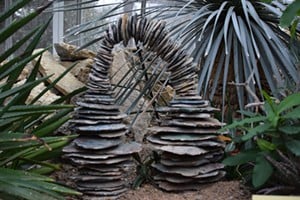
But the idea for the exhibition formed when Merida-Paytes asked Heider to create a video tour of her garden for 2020’s NCECA (National Council on Education for the Ceramic Arts) conference, which was postponed due to COVID-19 (The NCECA conference will be held March 15-18 in Cincinnati). During the pandemic, Heider says she began thinking of other ways to showcase the work of Merida-Paytes, Cartwright and Pulley.
That’s where the Krohn came in. Ceramics in a Garden will run through June 18 alongside other Krohn events like the current Bunnies and Blooms program and the annual Butterfly show, which kicks off March 25. As the seasons pass, plant life in the Krohn will go through different stages, affecting the art. Sometimes there will be tendrils of vines or blooms and other times, not.
“The change is so rapid (in the Krohn) that people could go back many times through the six months it’ll be there and the work will look different,” Heider says. “That’s one of the really neat things about having outdoor sculpture – the sculpture changes all the time with the seasons.”
One of the first pieces visitors will stumble upon is also the largest. "Cascade," by Columbus, Indiana-based artist Pulley, weighs in at 1,445 pounds, is 9 feet tall and sits outside on the Krohn’s entry plaza. Made up of multiple blocks, the sculpture was put up in segments. Heider says that as the piece was set up at the Krohn, curious onlookers gathered.
While much of Pulley’s work is smaller, he says he became interested in building human-scale work after seeing friends make larger pieces.
“I think these big pieces are apprehended differently,” Pulley says. “You feel it in your stomach and your guts instead of through your eyes and so you feel it in your body.”
Pulley notes that he works primarily in clay fired at a high temperature and is drawn to organic, stone-like surfaces and textures. Though his work looks like rock, his artist bio notes that the pieces are often hollow and lighter than they appear.
Pulley calls nature his muse, recalling time spent hiking in woods and alongside creek beds. Pulley also nods to Heider’s efforts in placing pieces in relation to plant life. Each piece in the exhibit has its own textures, colors and patterns, just like plants.
Heider says she wants to play on that complementary nature.
“I like working out those patterns,” Heider says. “And I hope that’s something that people will respond to, maybe without even realizing why they’re responding to it. There’s a symbiotic relationship.”
The exhibit also serves as an impetus for Pulley to revisit past work. He explains that 10 years after graduate school, he began creating vessels and basins with hollowed cavities. Having graduated with a master of arts degree in ceramics from Ball State University in 1979, Pulley returned to making basins decades after Heider expressed interest in them.
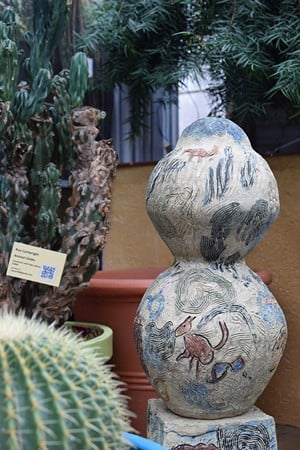
Cartwright and Merida-Paytes also contributed decades of work to the exhibit. Much of Merida-Paytes’ new work explores her recent diagnosis of spinocerebellar ataxia 5, a genetic disease that affects the spinal cord and cerebellum.
“She’s really interested in things that are alive and living and things that are decaying and deteriorating,” Heider says.
Krohn’s Fern House features several fish-related sculptures, including a string of skeletal fish by Merida-Paytes. Hung among the foliage, the piece is best experienced at multiple angles to fully see the fish’s colors, details and contortions. The Fern House also includes several fish sculptures by Cartwright, including ones perched atop bowls or swimming among the greenery, the trickling sound of water nearby.
In the 1990s, Merida-Paytes studied under Cartwright, the former, now-retired head of UC’s ceramics department. Heider says Cartwright and Merida-Paytes relate because of the unexpectedness of what they create.
“Lisa and Roy do a lot of work that is strange, unusual, raises questions, is a mystery,” Heider says. “Even the skeletal works Lisa does, they have a mysterious quality to them, I think. They complement each other.”
While Cartwright has more abstract pieces, Heider says Merida-Paytes’ work is always figurative. Aside from the aforementioned fish, the bulk of Cartwright’s art takes the shape of abstract botanical and animalistic forms. One might see anything from bunny ears to a paw or sisters emerge from any of his pieces. Similarly, Pulley’s work plays with textures and shapes.
For Pulley, the show is just as much about Heider’s vision for Ceramics in a Garden as it is about the individual pieces.
“The work is one thing. It’s discrete, but it can’t exist in a vacuum. So the time she’s put into them affects the way you see the work,” Pulley says. “She’s doing a really great job of imagining these pieces in their environment. And hopefully, people will be able to imagine them in their environment.”
Ceramics in a Garden runs through June 18 at the Krohn Conservatory, 1501 Eden Park Drive, Eden Park. Info: cincinnati-oh.gov/cincyparks.
Coming soon: CityBeat Daily newsletter. We’ll send you a handful of interesting Cincinnati stories every morning. Subscribe now to not miss a thing.
Follow us: Google News | NewsBreak | Reddit | Instagram | Facebook | Twitter

